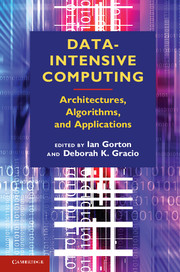Book contents
- Frontmatter
- Contents
- List of Contributors
- 1 Data-Intensive Computing: A Challenge for the 21st Century
- 2 Anatomy of Data-Intensive Computing Applications
- 3 Hardware Architectures for Data-Intensive Computing Problems: A Case Study for String Matching
- 4 Data Management Architectures
- 5 Large-Scale Data Management Techniques in Cloud Computing Platforms
- 6 Dimension Reduction for Streaming Data
- 7 Binary Classification with Support Vector Machines
- 8 Beyond MapReduce: New Requirements for Scalable Data Processing
- 9 Let the Data Do the Talking: Hypothesis Discovery from Large-Scale Data Sets in Real Time
- 10 Data-Intensive Visual Analysis for Cyber-Security
- Index
- References
1 - Data-Intensive Computing: A Challenge for the 21st Century
Published online by Cambridge University Press: 05 December 2012
- Frontmatter
- Contents
- List of Contributors
- 1 Data-Intensive Computing: A Challenge for the 21st Century
- 2 Anatomy of Data-Intensive Computing Applications
- 3 Hardware Architectures for Data-Intensive Computing Problems: A Case Study for String Matching
- 4 Data Management Architectures
- 5 Large-Scale Data Management Techniques in Cloud Computing Platforms
- 6 Dimension Reduction for Streaming Data
- 7 Binary Classification with Support Vector Machines
- 8 Beyond MapReduce: New Requirements for Scalable Data Processing
- 9 Let the Data Do the Talking: Hypothesis Discovery from Large-Scale Data Sets in Real Time
- 10 Data-Intensive Visual Analysis for Cyber-Security
- Index
- References
Summary
Introduction
In our world of rapid technological change, occasionally it is instructive to contemplate how much has altered in the last few years. Remembering life without the ability to view the World Wide Web (WWW) through browser windows will be difficult, if not impossible, for less “mature” readers. Is it only seven years since YouTube first appeared, a Web site that is now ingrained in many facets of modern life? How did we survive without Facebook all those (actually, about five) years ago?
In 2010, various estimates put the amount of data stored by consumers and businesses around the world in the vicinity of 13 exabytes, with a growth rate of 20 to 25 percent per annum. That is a lot of data. No wonder IBM is pursuing building a 120-petabyte storage array. Obviously there is going to be a market for such devices in the future. As data volumes of all types – from video and photos to text documents and binary files for science – continue to grow in number and resolution, it is clear that we have genuinely entered the realm of data-intensive computing, or as it is often now referred to, big data.
Interestingly, the term “data-intensive computing” was actually coined by the scientific community. Traditionally, scientific codes have been starved of sufficient compute cycles, a paucity that has driven the creation of ever larger and faster high-performance computing machines, typically known as supercomputers. The Top 500 Web site shows the latest benchmark results that characterize the fastest supercomputers on the planet.
- Type
- Chapter
- Information
- Data-Intensive ComputingArchitectures, Algorithms, and Applications, pp. 1 - 11Publisher: Cambridge University PressPrint publication year: 2012
References
- 1
- Cited by



